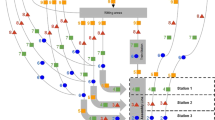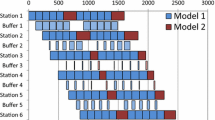Abstract
In the last decades, the necessity to make production more versatile and flexible has forced assembly line production systems to change from fixed assembly lines to mixed model assembly lines, where the output products are variations of the same base product and only differ in specific customizable attributes. Such assembly lines allow reduced setup time, since products can be jointly manufactured in intermixed sequences (Boysen, Flieder, Scholl. Jena Research Papers in Business and Economics, Friedrich-Schiller-Universitat Jena, 1;1–11, 2007a; Boysen, Flieder, Scholl. Jena Research Papers in Business and Economics, Friedrich-Schiller-Universitat Jena, 2;1–33, 2007b). Unfortunately, the installation of customization options typically leads to variations in process times, and when the cycle is exceeded within a certain station, an overload is created, forcing other stations to wait and idle. Normally, process time variation in an un-paced line are absorbed by buffers, but in some industrial application the buffer dimensions are critical not only for the reduction of work in progress but also in reducing other constrains (space, technology, model dimensions, etc.). The problem of balancing mixed model assembly lines (MALBP), in the long term, and that of sequencing mixed model assembly lines (MMS), in the short term (Merengo, Nava, Pozetti. Int J Prod Res 37:2835–2860, 1999), are the two major problems to solve. The object of this paper is to illustrate an innovative balancing–sequencing step-by-step procedure that aims to optimize the assembly line performance and at the same time contain the buffer dimensions in function of different market demand and production mix. The model is validated using a simulation software and an industrial application is presented.
Similar content being viewed by others
References
Merengo C, Nava F, Pozetti A (1999) Balancing and sequencing manual mixed-model assembly lines. Int J Prod Res 37:2835–2860
Scholl A (1995) Balancing and sequencing of assembly lines. Physica-Verlag, Heidelberg, pp 106–197
Anderson DR, Moodie CL (1969) Optimal buffer storage capacity in production line system. Int J Prod Res 7:233–240
Basu RN (1977) The interstage buffer storage capacity of non-powered assembly lines, a simple mathematical approach. Int J Prod Res 15:365–382
Conway R, Maxwell W, McClain JO, Thomas LJ (1988) The role of work in process inventory in serial production lines. Oper Res 36:299–241
Hopp WJ, Pati N, Jones PC (1989) Optimal inventory control in a production flow system with failures. Int J Prod Res 27:1367–1384
Szendrovitis AZ, Miltenburg GJ, Goldstein Z (1990) Optimizing total safety inventory or large transfer lines. OMEGA 18:299–313
Malakooti JLC (1994) Assembly line balancing with buffers by multiple criteria optimization. Int J Prod Res 32:2159–2178
Salveson ME (1955) The assembly line balancing problem. J Ind Eng 6:18–25
Battini D, Faccio M, Ferrari E, Persona A, Sgarbossa F (2007) Design configuration for a mixed-model assembly system in case of low product demand. Int J Adv Manuf Technol 34(1–2):189–200. doi:10.1007/s00170-006-0576-5
De Fokkert J, De Kok T (1996) The mixed and multi model line balancing problem: a comparison. Eur J Oper Res 100:399–412
Battini D, Faccio M, Persona A, Sgarbossa F (2008) The mixed model assembly line balancing problem: evalutation of the balancing methodologies in presence of variability of task time and demand, GBID 2008, Proceeding
Karp RM (1972) Reducibility among combinatorial problems. In: Miller RE, Thatcher JW (eds) Complexity of computer computation. Plenum, New York, pp 85–103
Berger I, Bourjolly JM, Laporte G (1992) Branch and bound algorithms for the multi-product assembly line balancing problem. Eur J Oper Res 58:215–222
Helgeson WB, Bimie DP (1961) Assembly line balancing using the ranked positional weight technique. J Ind Eng XII(6):394–398
Macaskill JLC (1972) Production-line balances for mixed-model lines. Manage Sci 19(4):423–434
Thomopoulos NT (1970) Mixed model line balancing with smoothed station assignments. Manage Sci 16:593–603
Arcus AL (1966) COMSOAL a computer method of sequencing operations for assembly lines. Int J Prod Res 4(4):259–277
Milas GH (1990) Assembly line balancing…Let’s remove the mystery. Ind Eng 22(5):31–36
Roberts SD, Villa CD (1970) On a multiproduct assembly line-balancing problem. AIIE Transactions, December, 361–364
Patterson JH, Albracht JJ (1975) Assembly line balancing, zero-one programming with Fibonacci search. Oper Res 23:166–172
Bard JF, Shtub A, Joshi SB (1994) Sequencing mixed-model assembly lines to level parts usage and minimize line length. Int J Prod Res 32:2431–2454
Ziegler H (1990) Produktionssteuerung bei Mehrproduktfliesslinien Manuscript, Universitat-GH-Paderborn, Fachbereich Wirtschaftswissenschaften
Vrat P, Virani A (1976) A cost model for optimal mix of balanced stochastic assembly line and the modular assembly system for a customer oriented production system. Int J Prod Res 14:445–463
Boysen N, Flieder M, Scholl A (2007a) The product rate variation problem and its relevance in real world mixed model assembly lines. Jena Research Papers in Business and Economics, Friedrich-Schiller-Universitat Jena, 1;1–11
Boysen N, Flieder M, Scholl A (2007b) Sequencing mixed-model assembly lines: survey, classification and model critique. Jena Research Papers in Business and Economics, Friedrich-Schiller-Universitat Jena, 2;1–33
Fliedner M, Boysen N (2007) Solving the car sequencing problem via Branch & Bound. Int J Oper Res, 2–20
McMullen PRM (1999) JIT sequencing for mixed-model assembly lines with setups using Tabu Search. Prod Plan Control 9(5):504–510
Hyun CJ, Kim Y, Kim YK (1998) A genetic algorithm for multiple objective sequencing problems in mixed model assembly lines. Comput Oper Res 25(7/8):675–690
McMullen PR, Frazier GV (2000) A simulated annealing approach to mixed-model sequencing with multiple objectives on a just-in-time line. IIE Trans 32:679–686
Kara Y, Ozcan U, Peker A (2007) Balancing and sequencing mixed-model just-in-time U-lines with multiple objectives. Appl Math Comput 184:566–588
Bautista J, Cano J (2008) Minimizing work overload in mixed-model assembly lines. Int J Prod Econ 112:177–191
Caridi M, Sianesi A (1999) Multi-agent system in production planning and control: an application to the scheduling of mixed-model assembly lines. Int J Prod Econ 68:29–42
Celano G, Fichera S, Grasso V, La Commare U, Perrone G (1991) An evolutionary approach to multi-objective scheduling of mixed model assembly lines. Comput Ind Eng 37:69–73
Celano G, Costa A, Fichera S, Perrone G (2001) Human factor policy testing in the sequencing of manual mixed model assembly lines. Comput Oper Res 21:39–59
Drexl A, Kimms A (2001) Sequencing JIT mixed model assembly lines under station load and part usage constrains. Manage Sci 47(3):480–491
Ho W, Ji P (2003) PCB assembly line assignment: a genetic algorithm approach. J Manuf Tech Manag 16(6):682–692
Kim YK, Hyun CJ, Kim Y (1996) Sequencing in mixed model assembly lines: a genetic algorithm approach. Comput Oper Res 23(12):1131–1145
Korkmazel T, Meral S (2001) Bicriteria sequencing methods for the mixed model assembly line in just-in-time production systems. Eur J Oper Res 131:188–207
Kurashige K, Yoshinari Y, Miyazaki S, Kameyama Y (1999) Sequencing method for products in consideration of assembly time. Int J Prod Econ 60–61:565–573
Mansouri SA (2004) A multi-objective genetic algorithm for mixed-model sequencing on JIT assembly lines. Int J Oper Res 167:696–716
Park MW, Kim YD (2000) A branch and bound algorithm for a production scheduling problem in an assembly system under due date constrains. Eur J Oper Res 123:504–518
Rahimi-Vahed AR, Mirghorbani SM, Rabbani M (2007) A new particle swarm algorithm for a multi objective mixed-model assembly line sequencing problem. Soft Comput 11(10):998–1011
Tavakkoli-Moghaddam R, Rahimi-Vahed AR (2006) Multi-criteria sequencing problem for a mixed-model assembly line in al JIT production system. Appl Math Comput 181:1471–1481
Ventura JA, Radhakrishnan S (2002) Sequencing mixed model assembly lines for a Just-in-time production system. Prod Planning Control 13(2):199–210
Xiaobo Z, Ohno K (1996) Algorithms for sequencing mixed models on an assembly line in a JIT production system. Comput Ind Eng 32(1):47–56
Xiaobo Z, Ohno K (1998) Properties of a sequencing problem for a mixed model assembly line with conveyor stoppages. Eur J Oper Res 124:560–570
Xiaobo Z, Liu J, Ohno K, Kotani S (2005) Modeling and analysis of a mixed-model assembly lime with stochastic operation times. Wiley, New York, pp 682–691
Xiaobo Z, Zhou Z, Asres A (1999) A note on Toyota’s goal of sequencing mixed models on an assembly line. Comput Ind Eng 36:57–65
Zhu J, Ding FY (2000) A transformed two-stage method for reducing the part usage variation and a comparison of the product-level and part-level solutions in sequencing mixed-model assembly lines. Eur J Oper Res 127:203–216
Ding FY, Zhu J, Sun H (2004) Comparing two weighted approaches for sequencing mixed-model assembly lines with multiple objectives. Int J Prod Econ 102:108–131
Inman RR, Schmeling DM (2003) Algorithm for agile assembly-to-order in the automotive industry. Int J Prod Res 41:3831–3848
O’Hare G, Jennings N (1996) Foundations of distributed artificial intelligence. Wiley and Sons, London
Author information
Authors and Affiliations
Corresponding author
Rights and permissions
About this article
Cite this article
Battini, D., Faccio, M., Persona, A. et al. Balancing–sequencing procedure for a mixed model assembly system in case of finite buffer capacity. Int J Adv Manuf Technol 44, 345–359 (2009). https://doi.org/10.1007/s00170-008-1823-8
Received:
Accepted:
Published:
Issue Date:
DOI: https://doi.org/10.1007/s00170-008-1823-8




